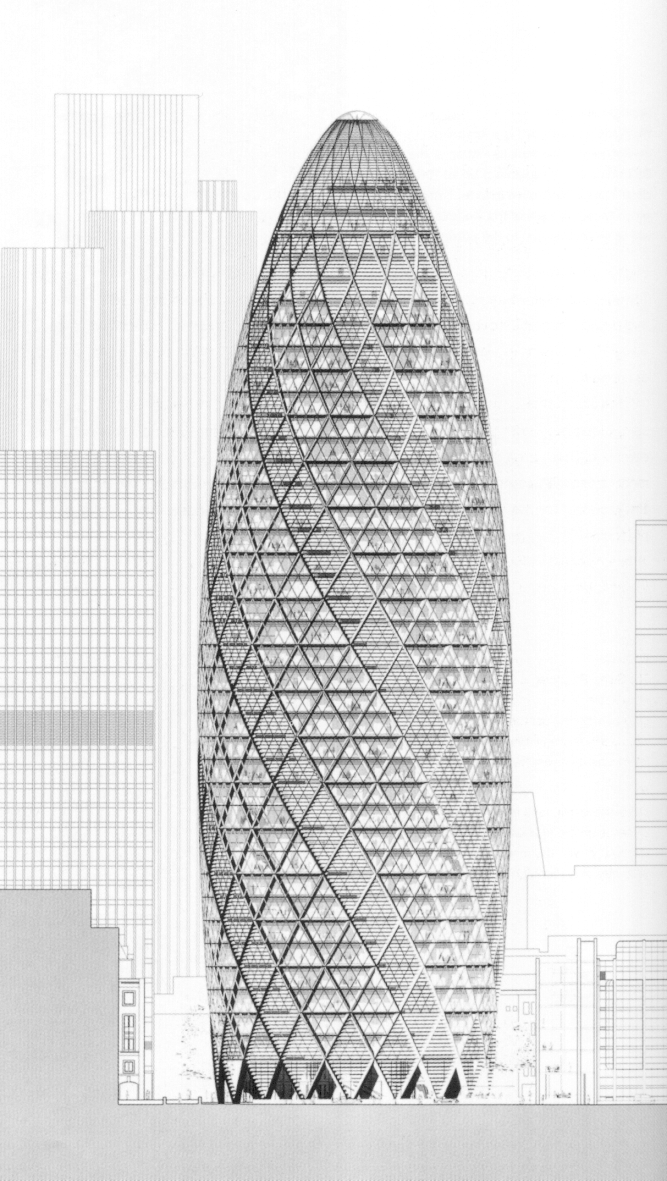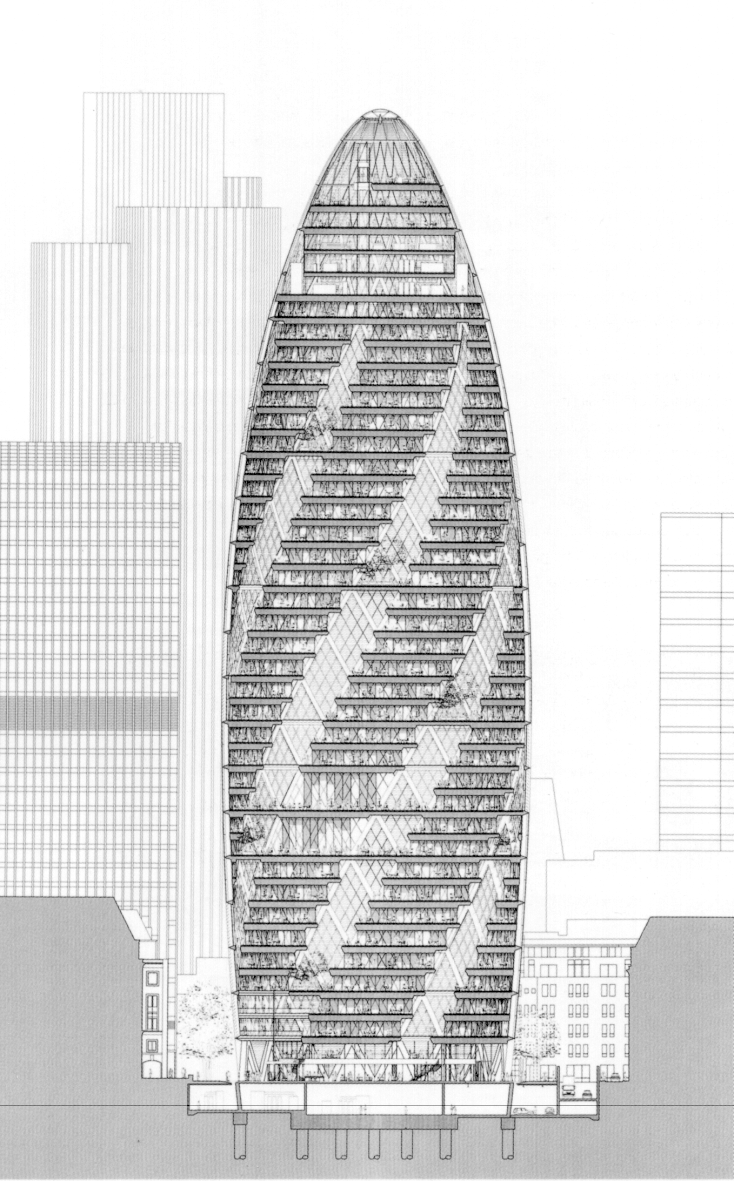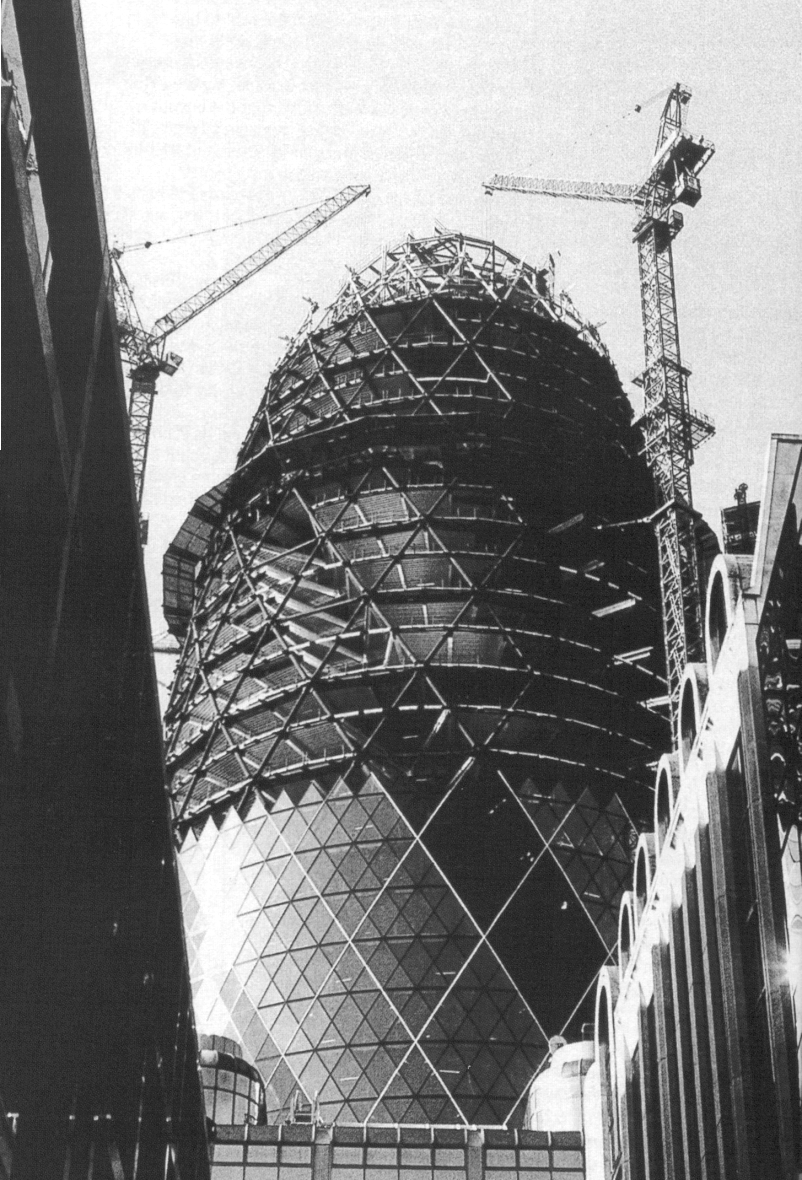|
|
| Notable Features | |
|
|
Steel frame structure |
|
|
Concrete slab on profiled metal decking |
|
|
Metal and glass prefabricated panels for external cladding |
|
|
Raised floor system |
|
|
Flexibility |
|
|
|
| Basic Information | |
| Location : | |
| 30 St Mary Axe, the City, London, UK | |
| Building Type : | |
| Office building grade A | |
| Contract Period : | |
|
2001-2004 |
|
| Contract Sum : | |
| £130 million GBP, US$190 million | |
| Gross Floor Area : | |
| 46,000 m2, 500,000 sqft. | |
| Developer : | |
| Swiss Reinsurance Company | |
| Client's Representative : | |
| RWG Associates | |
| Architect : | |
|
Foster and Partners |
|
| Structural Engineer : | |
| Ove Arup & Partners | |
| E&M Consultant : | |
| Hilson Moran Partnership Ltd. | |
| Cost Consultant : | |
| Gardiner & Theobald | |
| Acoustics/Audio Visual : | |
| Sandy Brown Associates | |
| Main Contractor : | |
| Skanska Construction | |
|
|
|
| . | |
| Overview | |

 |
|
|
The Swiss Re 40-storey building is located on the site of the former Baltic Exchange in the City of London. The 180m high building includes offices, retails at G/F and 1/F, a single basement, and a public plaza, the top of the building will be use for dining and events facilities by the building’s occupants and their guests. Next to the tower, a 6-storey Bury Street building accommodates houses office and plants rooms. |
|
|
|
|
| Slab Steel Decking | |
| The concrete slabs on profiled metal decking loading criteria are: for offices 3.5kPa + 1kPa demountable partitioning allowance. The metal decking minimizes construction waste, as it is a prefabricated permanent formwork. | |
|
|
|
| Other Information | |
|
|
Typical slab to slab heights: 4.15m |
|
|
Typical floor to ceiling height: 2.75m |
|
|
Typical raised floor level: 150mm |
|
|
Design planning module on office floors: 1.50m |
|
|
16 high-speed, high-capacity passenger lifts |
|
|
|
| Sources | |
|
|
Powell K., New London Architecture, Merrel Publishers Ltd, London, 2001. |
|
|
Quantrill M., The Norman Foster Studio: Consistency through Diversity, E&FN Spon, London, 1999. |
|
|
Foster N., On Foster…Foster On, Prestel, Munich, 2000. |
|
|
Skanska Construction web site: www.skanska.com |
|
|
Foster & Partners web site: www.fosterandpartners.com |
|
|
30 St Mary Axe web site: www.30stmaryaxe.co.uk |
|
|
|
| Building Shape and Structure |
 |
|
The building structure is designed to be environmentally friendly allowing daylight penetration at ground floor, minimizing wind loads on the structure and cladding, etc. |
| The tower has a circular plan that widens as it rises from the ground floor and tapers towards its apex. The building shape assists natural ventilation by drawing fresh air in through light wells spiraling up the building, reducing the need for conventional air conditioning. The light wells also maximize natural light to limit reliance on artificial lighting. Because of the inherent stiffness of the external diagrid, the central core is required to act only as a load-bearing element and is free from diagonal bracing, producing more flexible floor plates. |
|
|
| Steel Frame Structure |
| Founded on 324no 750mm-diameter (23m into the ground) reinforced concrete piles the structure comprises approximately 10,000te of structural steelwork that forms the core and outer diagonal grid (diagrid). The central lightweight core is constructed first, followed by the steel erection as well as the climbing of the tower cranes. The steel structure is fabricated in Holland and Belgium. Some 8,000 pieces of steel will be bolted together to form the tower, along with 160 flights of steel staircases. There are up to five deliveries of steel per day. Each element of steel is clad with fire resistant boarding to protect it against fire and the internal core walls are constructed using lightweight framing and plasterboard. For the top of the building, the manufacture of the structural steelwork is done in Austria. The use of steel structure minimizes construction and demolition waste as it is prefabricated and recyclable. |
|
|
| Cladding |
| The whole envelope is glass clad and the diagrid is internally enclosed in pressed aluminum panels. 144 diamond shaped panels are installed on each floor. Diamond shaped elements of glass are lifted into position by robotic machines and hooked onto bespoke brackets using floor-operated cranes. Gaskets between the elements ensure that the building remain watertight. Double-glazed panels of glass are positioned in front of the “Atrias”. |
|
|
| Contact of Contractor |
|
Skanska
Construction UK Ltd. |
|
|
| Photos |
|
Photos of the
construction are available on the Internet: |
|
|
